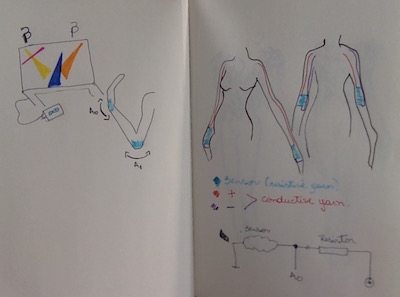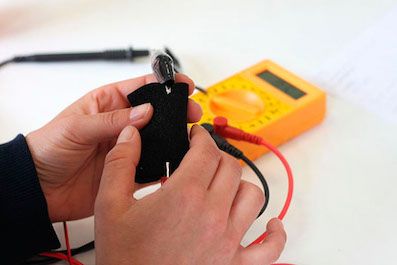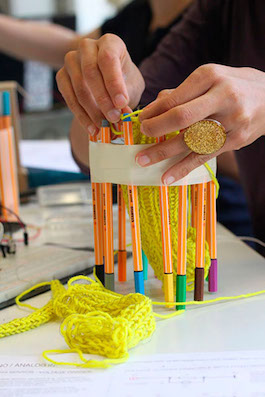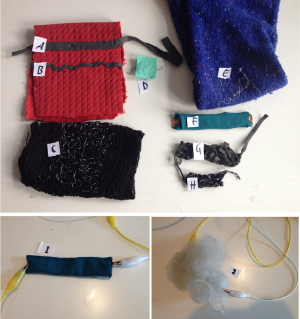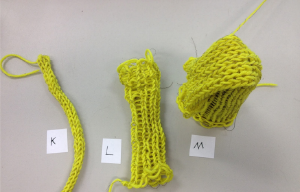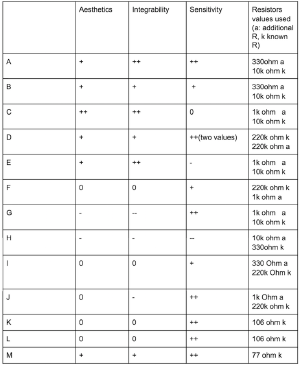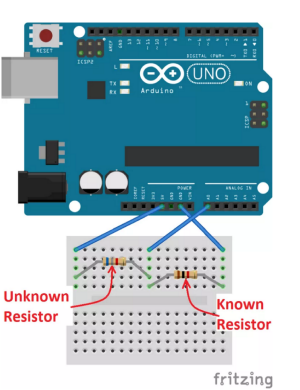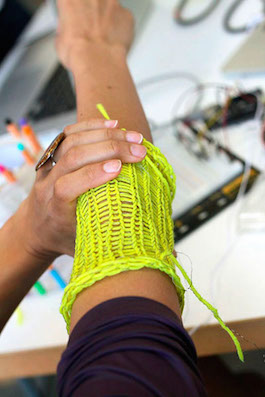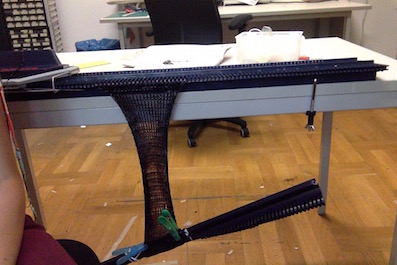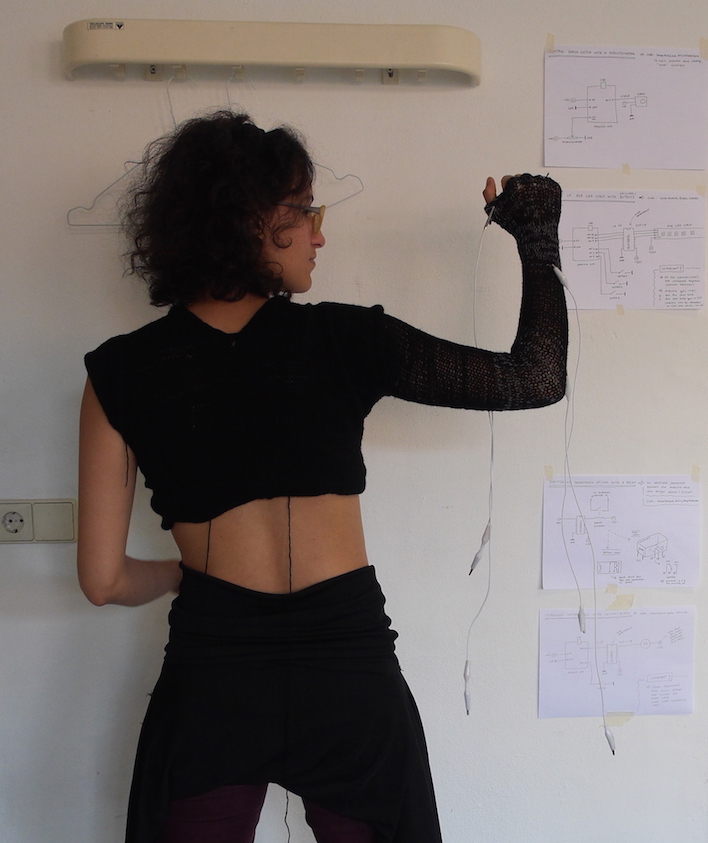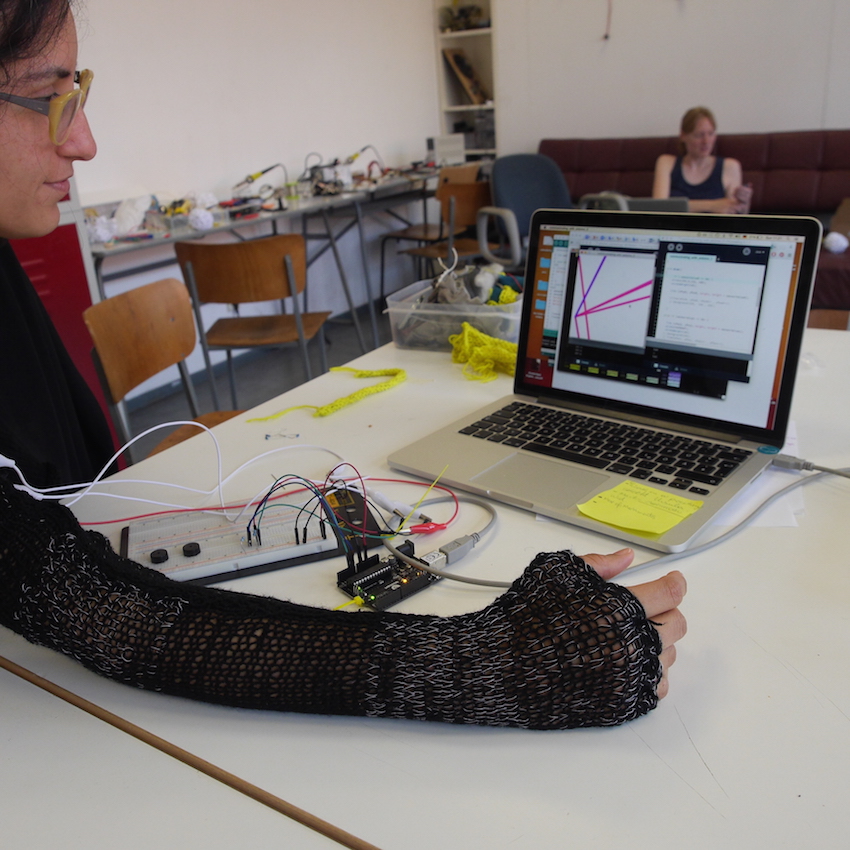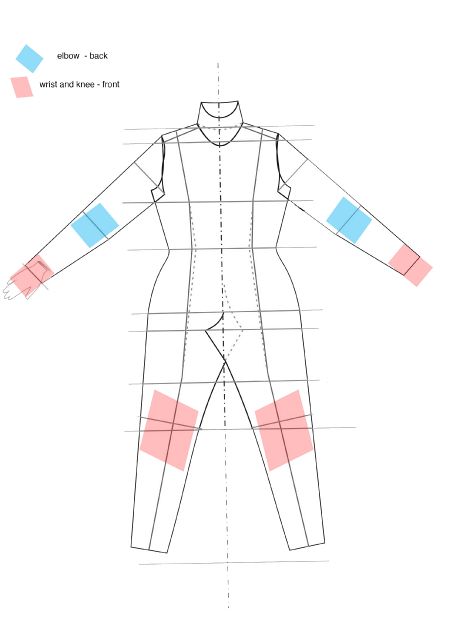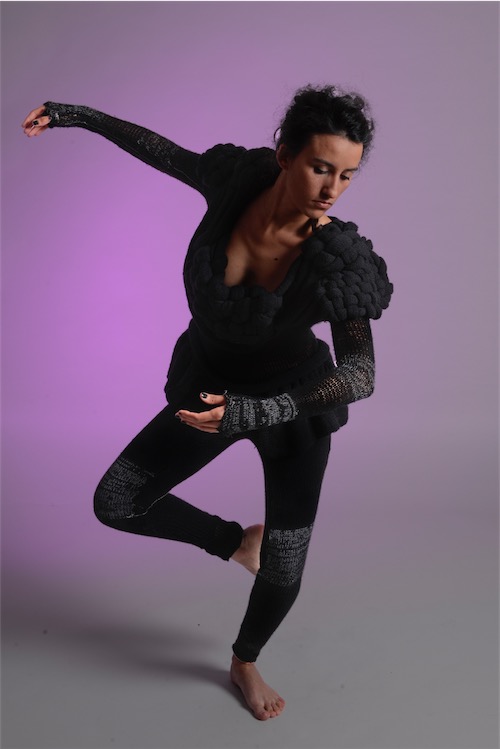No edit summary |
No edit summary |
||
| (40 intermediate revisions by the same user not shown) | |||
| Line 1: | Line 1: | ||
Project overview | '''Project overview''' | ||
My intention is to explore textiles. The textiles' matter have been part of my life tour since back in Brazil where I used to work as fashion designer. Therefore, since this module had the goal to explore sensor, some of the textile’s possibilities was tested mainly as stretch sensor but also push and bending | My intention is to explore textiles. The textiles' matter have been part of my life tour since back in Brazil where I used to work as fashion designer. Therefore, since this module had the goal to explore sensor, some of the textile’s possibilities was tested mainly as stretch sensor but also push and bending sensor. I’ve tested conductive and resistive textiles, conductive and resistive yarns as well as the knitting and crochet technique in order to develop the stretch sensor | ||
At first, those experimentations was made without final project propose until the point that it was possible to figure out the boundary of the e-textile as well as e-yarns. The result presented during the last meeting was the visualisation of the movements made by my wrist and elbow captured from the stretch textile sensor. With that idea have the intention to empower two skill: computing code and elaborate integrated circuits in textiles. | At first, those experimentations was made without final project propose until the point that it was possible to figure out the boundary of the e-textile as well as e-yarns. The result presented during the last meeting was the visualisation of the movements made by my wrist and elbow captured from the stretch textile sensor. With that idea have the intention to empower two skill: computing code and elaborate integrated circuits in textiles. | ||
| Line 7: | Line 7: | ||
[[File:Textile sensor.jpg ]] | [[File:Textile sensor.jpg ]] | ||
'''Prototyping experiments''' | |||
Hands on! Banding sensor, push button and stretch sensor was made out of textile. | |||
The stretch sensor was the one that I most like, however, in order to make it, at first I had to set up a type of knitting machine as know as "french machine". | |||
[[File:Textile sensor1.jpg ]] | [[File:Textile sensor1.jpg ]] [[File:Textile sensor2.jpg ]] | ||
Bellow you can see the experiments that I did: | |||
[[File:Tests1.jpg |300px]] [[File:Tests2.jpg|300px ]] | |||
A- Resistive fabric in stripe <br> | |||
B- Resistive fabric in zig-zag <br> | |||
C- Normal tread + resistive yarn - crochet technique <br> | |||
D- Push sensor made out of fabric, conductive yarn and velostat <br> | |||
E- Resistive yarn applied in a already made clothe (with needle I followed the way the thread goes, applying the resistive yarn on it) <br> | |||
F -Bending sensor made out of fabric, conductive yarn and velostat <br> | |||
G- Resistive fabric used as thread - crochet technique <br> | |||
H- Conductive yarn + normal thread - crochet technique <br> | |||
I- Bending Sensor made out of fabric, resistive yarn and velostat <br> | |||
J-Resistive Wool <br> | |||
K,L,M - Resistive yarn with normal thread - knitting technique (in different sizes) <br> | |||
So, I've decided to make a evaluation table. Since my intention became to make a sleeve sensor, to after make a whole body suit, I took in consideration important aspects in a point of view of a fashion designer. | |||
1- Aesthetics - I don't want something ugly! <br> | |||
2-Integrability- Because in the future would be nice not to attach a "button" in a t-shirt but make in literally the push button itself <br> | |||
3- Sensitivity - which technique is the best for a sensor that I am looking for?! <br> | |||
[[File:Tests3.jpg|300px]] | |||
Until this point I was trying to figure out which value of resistances were the best to deliver a bigger range of values in the serial monitor, therefore I took notes. Kati in a consultation taught that if one measure in the multimeter the highest and lowest voltage, add those values and dived by two, one will be able to have the average voltage and use this average voltage value as a resistor and therefore, have the best performance possible from the sensor. | |||
[[File:Textile sensor9.jpg|300px]] | |||
I took the decision to work the the knitted stretch sensor. Besides the aesthetic be passive to look like granny style, it was very responsive and the technology is really integrated in the textile surface (and not attached). | |||
[[File:Tests4.jpg|300px]] | [[File:Tests4.jpg|300px]] | ||
Here you can check the [https://vimeo.com/167719503 video] of a test I've done with the stretch sensor I choose to work with, and [https://github.com/AlineMa/Sensor_Hack_Lab/blob/master/Playing_Tone_1Input here] is the code. | |||
After play with my sensor, the next step it was to design 2 sensors in the same garment, therefore I used a Junior Knitting Machine. | |||
[[File:Textile sensor8.jpg ]] | |||
As you see in my sleeve prototype I have one sensor in the wrist and another in the elbow. | |||
Here you [https://github.com/AlineMa/Sensor_Hack_Lab/commit/e459d411554756dcb22ebda8e9bad4ec937ee2c7 have] the code I used to generate tone sounds out of two inputs | |||
[[File:Tests5.jpg]] | |||
Since the beginning I was expecting to learn more about Arduino and Processing so I've decided to have visualisation as output. I mean that by moving my wrist and elbow it will be generated images on the screen. | |||
[[File: Visualisation.jpg]] | |||
I used this code to understand how to connect Arduino with Processing | |||
https://learn.sparkfun.com/tutorials/connecting-arduino-to-processing | |||
But this code didin't work when I decided to work with 2 inputs | |||
http://mycours.es/gamedesign2013/analog/ | |||
http://forum.arduino.cc/index.php?topic=40350.0 | |||
https://processing.org/discourse/beta/num_1169812504.html | |||
https://processing.org/discourse/beta/num_1193069410.html | |||
http://www.instructables.com/id/Arduino-to-Processing-Serial-Communication-withou/ | |||
It was with this code I made the communication with two sensors work properly and than I had only to re-write do code in order have the output I was expecting. | |||
http://www.instructables.com/id/Arduino-Serial-Data-Plotter/ | |||
My code right now is like [https://github.com/AlineMa/Sensor_Hack_Lab/commit/abd4219d936e4755c5d50d9cefa718e92a854609 this] | |||
[[File:Costume.jpg|450px]] | |||
[[File: | [[File:Costume2.jpg]] | ||
Latest revision as of 12:51, 22 August 2016
Project overview
My intention is to explore textiles. The textiles' matter have been part of my life tour since back in Brazil where I used to work as fashion designer. Therefore, since this module had the goal to explore sensor, some of the textile’s possibilities was tested mainly as stretch sensor but also push and bending sensor. I’ve tested conductive and resistive textiles, conductive and resistive yarns as well as the knitting and crochet technique in order to develop the stretch sensor
At first, those experimentations was made without final project propose until the point that it was possible to figure out the boundary of the e-textile as well as e-yarns. The result presented during the last meeting was the visualisation of the movements made by my wrist and elbow captured from the stretch textile sensor. With that idea have the intention to empower two skill: computing code and elaborate integrated circuits in textiles.
Prototyping experiments
Hands on! Banding sensor, push button and stretch sensor was made out of textile. The stretch sensor was the one that I most like, however, in order to make it, at first I had to set up a type of knitting machine as know as "french machine".
Bellow you can see the experiments that I did:
A- Resistive fabric in stripe
B- Resistive fabric in zig-zag
C- Normal tread + resistive yarn - crochet technique
D- Push sensor made out of fabric, conductive yarn and velostat
E- Resistive yarn applied in a already made clothe (with needle I followed the way the thread goes, applying the resistive yarn on it)
F -Bending sensor made out of fabric, conductive yarn and velostat
G- Resistive fabric used as thread - crochet technique
H- Conductive yarn + normal thread - crochet technique
I- Bending Sensor made out of fabric, resistive yarn and velostat
J-Resistive Wool
K,L,M - Resistive yarn with normal thread - knitting technique (in different sizes)
So, I've decided to make a evaluation table. Since my intention became to make a sleeve sensor, to after make a whole body suit, I took in consideration important aspects in a point of view of a fashion designer.
1- Aesthetics - I don't want something ugly!
2-Integrability- Because in the future would be nice not to attach a "button" in a t-shirt but make in literally the push button itself
3- Sensitivity - which technique is the best for a sensor that I am looking for?!
Until this point I was trying to figure out which value of resistances were the best to deliver a bigger range of values in the serial monitor, therefore I took notes. Kati in a consultation taught that if one measure in the multimeter the highest and lowest voltage, add those values and dived by two, one will be able to have the average voltage and use this average voltage value as a resistor and therefore, have the best performance possible from the sensor.
I took the decision to work the the knitted stretch sensor. Besides the aesthetic be passive to look like granny style, it was very responsive and the technology is really integrated in the textile surface (and not attached).
Here you can check the video of a test I've done with the stretch sensor I choose to work with, and here is the code.
After play with my sensor, the next step it was to design 2 sensors in the same garment, therefore I used a Junior Knitting Machine.
As you see in my sleeve prototype I have one sensor in the wrist and another in the elbow. Here you have the code I used to generate tone sounds out of two inputs
Since the beginning I was expecting to learn more about Arduino and Processing so I've decided to have visualisation as output. I mean that by moving my wrist and elbow it will be generated images on the screen.
I used this code to understand how to connect Arduino with Processing
https://learn.sparkfun.com/tutorials/connecting-arduino-to-processing
But this code didin't work when I decided to work with 2 inputs
http://mycours.es/gamedesign2013/analog/
http://forum.arduino.cc/index.php?topic=40350.0
https://processing.org/discourse/beta/num_1169812504.html
https://processing.org/discourse/beta/num_1193069410.html
http://www.instructables.com/id/Arduino-to-Processing-Serial-Communication-withou/
It was with this code I made the communication with two sensors work properly and than I had only to re-write do code in order have the output I was expecting.
http://www.instructables.com/id/Arduino-Serial-Data-Plotter/
My code right now is like this
